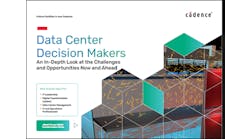As microgrids emerge as an option for data center power, DCF is partnering with Microgrid Knowledge to provide the best available information on the topic. Our two publications are teaming on a series of white papers and a virtual event to offer deep expertise on microgrids and data centers. Here's more on the white papers.
The internet is an essential tool of the modern world, and the data centers and servers that comprise the backbone of the internet have become critical infrastructure.
With more than 5 billion people online every day (and nearly 20,000 new internet users every hour), access to the internet is increasingly essential. Many of the systems that businesses and the public depend on rely on digital systems to function.
Worldwide, the estimated 7 million data centers that underpin the internet consume roughly 3% of the global electricity supply and represent nearly 2% of total greenhouse gas emissions.
With so many people and systems interconnected through the internet, disruptions and downtime at data centers have widespread impacts that can shut down critical systems, disable infrastructure and ripple through the economy.
When downtime is measured in the tens of thousands of dollars per minute, the value of resilience is much more immediate and tangible, leading many data center owners and operators to explore microgrids for resilience and cost savings.
Join the editors of Data Center Frontier and Microgrid Knowledge for a 3-part webinar series on Microgrids for Data Centers - Registration is Free.The Value of Data Center Resilience
Often caused by either loss of grid power or failure of onsite power equipment, these disruptive events are not rare. More than 60% of data center operators have reported an outage in the past three years, according to Uptime Institute’s 2022 Global Data Center Survey.
The cost of an outage at a data center can range from a few hundred dollars for a small business to tens of thousands of dollars per minute at a large “server farm,” making the need for improved energy resilience as much about economics as performance for customers.
And as dependence on digital resources grows, the effects of data center customers losing their access can ripple through the economy – like when an electrical failure at a Delta Airlines data center caused 2,000 flights to be grounded and more than $150 million in losses over three days.
To mitigate the risk of an outage, more than 40% of data center owners reported making significant investments recently in the resilience of their physical infrastructure and increasing system redundancies. And while reliability rates for data centers are seeing incremental improvements, the costs of outages continue to escalate.
With the average cost of a single data center outage reaching $750,000 (and cloud hosting services an order of magnitude more), many operators are now going beyond temporary power solutions and taking advantage of the benefits of microgrids to ensure system uptime even when the grid goes down for extended periods of time.
Where to Begin
The term “microgrid’’ encompasses a wide array of technologies and solutions that can be intimidating or confusing to the uninitiated.
A microgrid is a resilient energy system that serves a discrete geographic footprint, such as a campus, medical complex, business center or neighborhood. In many ways, it is a mini version of the main electric grid.
The team at Microgrid Knowledge, in collaboration with Data Center Frontier, has developed a three-part white paper series, described below, to help educate data center operators as they explore microgrids to improve electric resilience, lower energy costs and achieve sustainability goals.
Part I: A Compelling Case for Microgrids
There are a number of things that can malfunction within a data center – from complex cooling systems going offline to basic human error. But a rising point of concern is the electric grid itself, which is getting steadily more expensive while becoming increasingly less reliable in the face of aging infrastructure and the worsening impacts of climate change.
The key piece of technology that makes a microgrid a microgrid is the controller – hardware and software that allows the microgrid to separate from the main grid during power outages and use its on-site generators to supply power to a data center or campus of buildings. This means that when there is a power outage, the on-site system can take over automatically and keep everything running seamlessly until grid power can be restored.
Going beyond backup power to create an integrated microgrid system that improves both uptime and performance while reducing energy costs makes for a compelling case.
See Part I: The Case for Microgrids at Data Centers
Part II: Develop a Plan
While the overarching benefits of microgrids are clear, any business owner will want to understand how this applies to them and fits their particular set of needs.
Microgrids by nature are modular and adaptable, and the first step in developing a microgrid is to undertake a power and energy assessment. A data center should assess both its energy and power needs. This will not only help size the microgrid, but also determine likely points of failure and pinpoint critical operations that must not lose power.
Microgrids can be designed to operate with different levels of resilience. Some ensure energy for an entire building or campus indefinitely should the electric grid fail. Others are built to only protect critical infrastructure and enable safe shutdown procedures. These varying levels of integration, resilience and independence come with corresponding costs.
See Part II: Planning for Your Microgrid
Part III: Bring the Pieces Together
With the scope of a proposed microgrid in hand, the next step for a data center is implementation. The last part of the white paper series delves into the cost of a microgrid, financing and incentives, construction, testing and operations.
Depending on the microgrid’s complexity, moving from signing the paperwork to flipping the switch can take a few months to multiple years. Because microgrids are modular, installation can usually be done with limited inconvenience, if any, to a facility's normal operations. Microgrids also can be integrated when a facility is first built.
See Part III: Implementing Your Microgrid
Join the editors of Data Center Frontier and Microgrid Knowledge for a 3-part webinar series on Microgrids for Data Centers - Registration is Free.The Future of Resilient Data
Data centers seeking solutions for resilient energy infrastructure would be well served to consider the potential benefits and cost savings that microgrids can provide versus the traditional uninterruptible power supply and generator solutions.
The impacts of data center outages quickly reach beyond the walls of the building and lack of power reliability doesn’t have to be the leading cause. With millions of dollars at risk and new threats to reliability emerging, microgrids can be key to the resilient data networks of the future.





